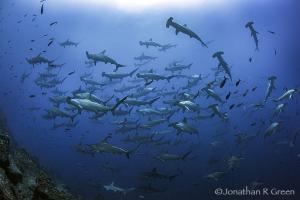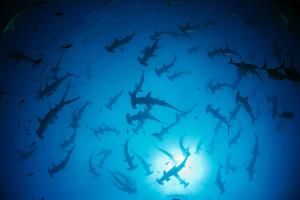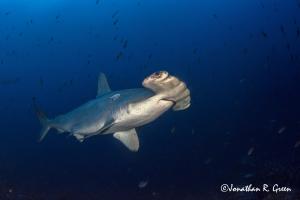
Exceptional Diving Conditions in the Galapagos Islands Amid Climate Transition
Unprecedented hammerhead shark sightings make 2024 a prime year for diving in the Galapagos Islands during the transition from El Niño to La Niña.
Jonathan R. Green, a renowned shark scientist in the Galapagos, notes, "The transition between El Niño and La Niña might be creating an optimal environment for marine life, particularly hammerhead sharks. This year, we are witnessing unprecedented sightings of large hammerhead schools, offering divers a rare and thrilling experience."
The Impact of El Niño and La Niña on the Galapagos Ecosystem
El Niño and La Niña are climatic phenomena that significantly influence the Galapagos ecosystem. These events are driven by variations in the Pacific Ocean’s temperatures and trade winds, creating distinct environmental conditions that impact both marine and terrestrial life.
During El Niño years, the trade winds weaken, and warm water spreads eastward across the Pacific Ocean. This leads to higher sea surface temperatures around the Galapagos Islands. The warm waters reduce the upwelling of cold, nutrient-rich water, causing a decline in marine productivity. Consequently, species that depend on these nutrients, such as fish, penguins, and marine iguanas, struggle to find food, which can lead to decreased populations and breeding success. However, the warm waters and increased rainfall foster abundant vegetation on land, benefiting terrestrial species like finches, Galapagos tortoises, and land iguanas. These periods of lush growth provide a spectacular sight for visitors as the islands turn green and wildlife thrives.
In contrast, La Niña events are characterized by stronger-than-average trade winds and colder sea surface temperatures. The increased winds promote upwelling of nutrient-rich waters, leading to a boom in marine life. Species such as sea lions, marine iguanas, and various fish thrive during these times, making it an excellent period for observing marine biodiversity. However, the colder and drier conditions can create challenges for terrestrial life, leading to droughts and a scarcity of vegetation. This results in a stark contrast to El Niño years, where the focus shifts to marine life abundance rather than land-based flora and fauna.
Understanding these patterns helps explain why certain years, such as 2024, offer unique diving opportunities. The interplay between these climatic events creates a dynamic and ever-changing environment, highlighting the importance of adaptability for both wildlife and visitors.
Unprecedented Hammerhead Shark Activity
This year, the climatic transition is believed to be driving the remarkable increase in hammerhead shark sightings. Divers are reporting larger schools and more frequent encounters with these magnificent creatures. "The conditions this year are unlike any we have seen in recent history," says Jonathan R. Green. "The abundance of hammerhead sharks is a testament to the dynamic and ever-changing nature of the Galapagos ecosystem." While the increased hammerhead shark activity could be due to the transition between climate effects, it could also have other underlying reasons.
Why 2024 is the Year to Dive in the Galapagos
Given the current conditions, 2024 presents a unique opportunity for divers to experience the Galapagos Islands at their best. The combination of increased marine life activity and the stunning underwater landscapes makes it a prime destination for underwater exploration. Additionally, water temperatures are back to average and have not yet dropped to the colder levels expected during La Niña, providing comfortable conditions for divers.
However, it is crucial to remember the fragile nature of the Galapagos ecosystem. Responsible and sustainable travel is essential to ensure that the islands remain pristine for future generations. Travelers are encouraged to choose operators committed to conservation and minimizing their environmental impact.
Traveling Responsibly in the Galapagos
The Galapagos Islands' ecosystem is delicate and requires careful stewardship. Visitors should prioritize traveling with responsible and sustainable operators who adhere to strict guidelines to protect the environment. These measures ensure that the natural beauty and biodiversity of the Galapagos are preserved, allowing for continued enjoyment and study of this unique ecosystem.
About Galapagos Shark Diving
Galapagos Shark Diving provides unique, sustainable diving experiences focused on protecting and understanding the marine environment of the Galapagos Islands. As a responsible operator, they offer unique experiences with a shark scientist on board, allowing divers to actively participate in Citizen Science projects.
Join a Special 15-Day Expedition
A special 15-day diving expedition is available for those wishing to contribute to marine science and experience the Galapagos' underwater beauty. Divers will spend up to seven full days in the northern archipelago (Darwin & Wolf), considered one of the 'sharkiest' places on earth, and visit other exceptional dive sites along with great land excursions. This expedition offers a comprehensive experience, unmatched by other liveaboard providers, ensuring divers get the best of what the Galapagos has to offer. For more information and to reserve a spot, visit the Galapagos Shark Diving webpage.
Conclusion
As the Galapagos Islands transition potentially into a La Niña year, 2024 emerges as an exceptional year for diving enthusiasts. The increased activity of hammerhead sharks and the unique climatic conditions offer an unparalleled experience for those looking to explore the underwater wonders of this remarkable archipelago. By choosing to travel responsibly, divers can enjoy the natural beauty of the Galapagos while contributing to its preservation.
Jenny Waack
Galapagos Shark Diving
+1 201-448-8192
info@galapagossharkdiving.com
Visit us on social media:
Facebook
X
LinkedIn
Instagram
YouTube
TikTok
Other
Unprecedented Hammerhead Shark Sightings in the Galapagos Islands
Distribution channels: Education, Environment, Science, Travel & Tourism Industry, World & Regional
Legal Disclaimer:
EIN Presswire provides this news content "as is" without warranty of any kind. We do not accept any responsibility or liability for the accuracy, content, images, videos, licenses, completeness, legality, or reliability of the information contained in this article. If you have any complaints or copyright issues related to this article, kindly contact the author above.
Submit your press release


